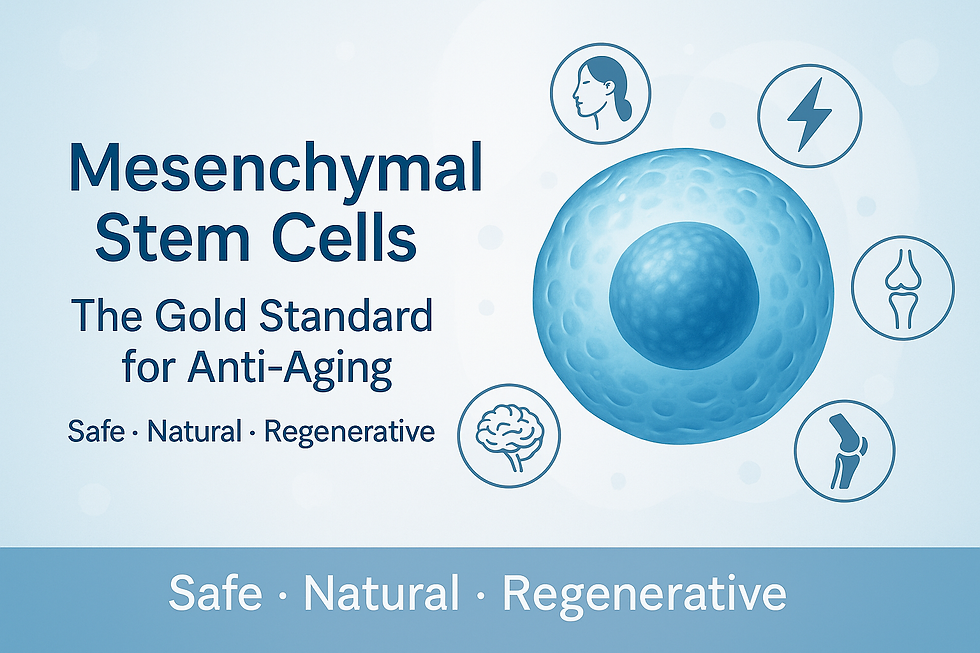Lab-Expanded vs Native Stem Cells: What’s the Difference and Why It Matters
- Revival Clinic Team

- Aug 24
- 4 min read

Stem cell therapy has become one of the most sought-after regenerative treatments in the world. But as interest grows, so does confusion — especially around the quality and type of stem cells used. One critical distinction is between lab-expanded and native stem cells.
At Revival Clinic Bangkok, we specialize in lab-expanded, xeno-free mesenchymal stem cells (MSCs) that meet international quality and safety standards. In this article, we’ll explore the difference between native and expanded stem cells, why it matters for anti-aging and healing, and how to make sure you're receiving high-quality treatment.
What Are Stem Cells and Why Are They Important?
Stem cells are unique cells that can:
Self-renew (make more of themselves)
Differentiate into specialized cells (like cartilage, muscle, or skin)
Communicate with other cells to reduce inflammation and promote repair
They are widely used in anti-aging, immune modulation, joint repair, and tissue regeneration. However, the source and preparation of stem cells directly affect how well they work — and whether they’re safe.
What Are Native Stem Cells?
Native stem cells refer to cells that are:
Extracted directly from tissue (e.g., fat or bone marrow)
Used without being cultured or multiplied in a lab
Given to the patient in the same session or within a short time
This is sometimes called “point-of-care” stem cell therapy.
Limitations of Native Stem Cells:
Low cell count: The quantity of viable stem cells is usually very small — especially in older adults
Reduced potency: Stem cells from older patients may be aged, less effective, or stressed
No quality control: The exact dose and viability can’t be measured accurately
Not ideal for systemic conditions: Low numbers of cells may not be sufficient for whole-body anti-aging or immune therapy
A study published in Stem Cell Reports (2020) confirmed that native adipose-derived stem cells from older individuals have significantly lower proliferation and differentiation capacity compared to those from umbilical cord tissue or lab-expanded cells.
What Are Lab-Expanded Stem Cells?
Lab-expanded stem cells are stem cells that have been:
Collected from young, healthy tissue (typically umbilical cord)
Isolated and multiplied under sterile, controlled lab conditions
Counted, tested for viability, and certified for clinical use
Each batch contains millions of potent, uniform mesenchymal stem cells ready for therapeutic infusion or injection.
Advantages of Lab-Expanded Stem Cells:
High potency: Derived from young donors, often from umbilical cord tissue
Consistent quality: Cultured in cleanroom environments and tested for sterility, viability, and surface markers
Customizable doses: The number of cells can be adjusted based on the patient’s condition
Suitable for systemic IV infusion: Ensures the patient receives an effective, therapeutic dose
Why This Matters for Anti-Aging and Regenerative Outcomes
The effectiveness of stem cell therapy depends on:
Number of viable cells
Cell potency
Ability to survive and act in the body
Consistency from batch to batch
Patients who receive low-dose, unexpanded native stem cells may not experience meaningful results, especially for:
Full-body rejuvenation
Autoimmune or inflammatory conditions
Advanced age-related tissue degeneration
At Revival Clinic, we use lab-expanded, xeno-free umbilical cord MSCs to ensure:
Higher success rates
Minimal side effects
Consistent patient experience
Learn more about our stem cell therapy treatments.
Safety and Quality Control at Revival Clinic Bangkok
We use stem cells that are expanded in sterile, quality-controlled lab environments
All batches are tested for:
Sterility
Viability (live cells)
Surface markers to confirm identity as MSCs
Our stem cells are xeno-free — meaning no animal components
We provide full transparency regarding sourcing, batch numbers, and certificates
These standards make Revival Clinic a top choice for international patients seeking safe, advanced regenerative medicine in Southeast Asia.
Summary: Lab-Expanded vs Native Stem Cells
Feature | Native Stem Cells | Lab-Expanded Stem Cells |
Cell quantity | Low (especially in adults) | High (10–100 million+ cells) |
Potency | Varies with donor age | Young, potent, consistent |
Safety testing | Limited | Full sterility and viability tests |
Cost | Usually cheaper | Slightly more, but higher efficacy |
Best for | Localized joint cases | Systemic anti-aging and inflammation |
FAQ
Q: Are lab-expanded stem cells safe?
A: Yes, when sourced from licensed labs that follow cleanroom and testing protocols. All our stem cells are tested for sterility, viability, and clinical quality.
Q: Do older people benefit from native stem cells?
A: Older individuals often have fewer viable stem cells. Lab-expanded, young donor cells are typically more effective.
Q: Can I request native stem cells instead?
A: Revival Clinic only uses lab-expanded stem cells to ensure the highest safety and effectiveness for systemic therapies.
Ready to Experience the Benefits of Premium Stem Cell Therapy?
If you're looking for results-driven, professional anti-aging or regenerative care, Revival Clinic Bangkok offers one of the most advanced and trustworthy stem cell therapy protocols in the region.
Contact us today to schedule a consultation or receive a custom treatment recommendation.
References
Squillaro, T., Peluso, G., & Galderisi, U. (2016). Clinical trials with mesenchymal stem cells: An update. Cell Transplantation, 25(5), 829–848. https://doi.org/10.3727/096368915X689622
Vizoso, F. J., et al. (2017). Mesenchymal stem cell secretome: Toward cell-free therapeutic strategies in regenerative medicine. International Journal of Molecular Sciences, 18(9), 1852. https://doi.org/10.3390/ijms18091852
Samsonraj, R. M., et al. (2017). Concise review: Multifaceted characterization of human mesenchymal stem cells for use in regenerative medicine. Stem Cells Translational Medicine, 6(12), 2173–2185. https://doi.org/10.1002/sctm.17-0123
Jin, H. J., et al. (2016). Aging reduces the efficacy of mesenchymal stem cells in patients. Stem Cells International, 2016, Article ID 2152435. https://doi.org/10.1155/2016/2152435



Comments